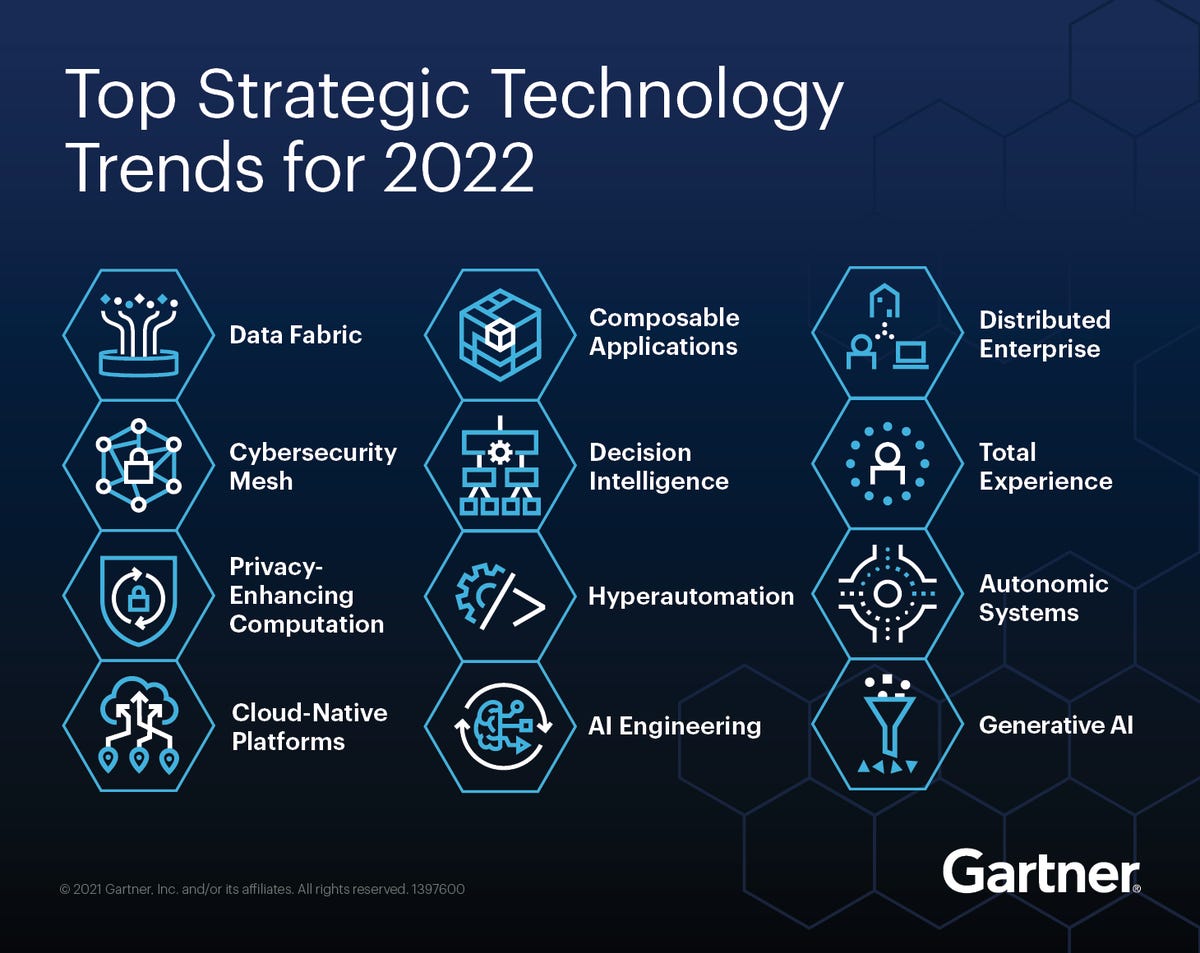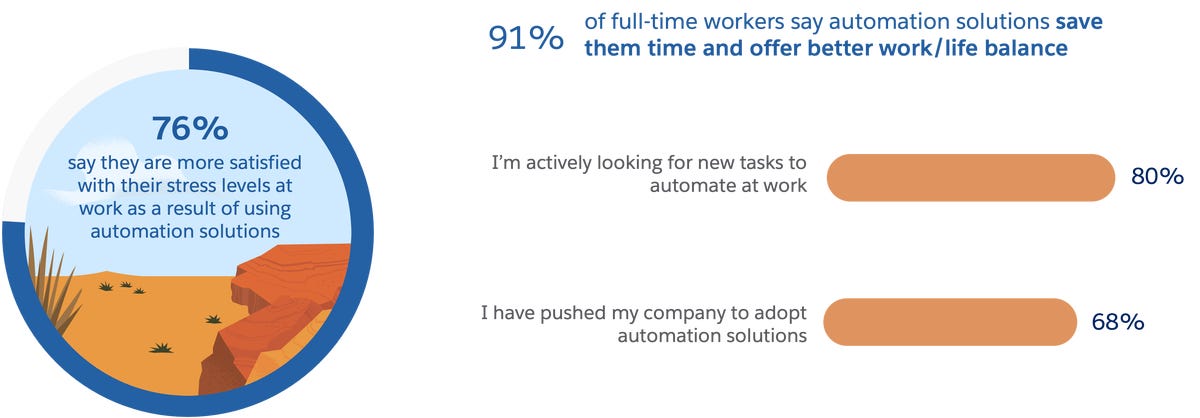
Written by
Vala Afshar, Contributor

Vala Afshar
Contributor
Vala Afshar is the Chief Digital Evangelist for Salesforce. Afshar is the author of The Pursuit of Social Business Excellence.
Full Bio
on December 8, 2021
| Topic: Digital Transformation

New research links lower stress levels and business automation

Gartner Top Strategic Technology Trends 2022
Gartner
75% of large enterprises will use at least four low-code development tools by 2024, and that low-code will make up more than 65% of application development activity.
Automation is a key digital transformation trend for 2021 and beyond. https://t.co/t2i56PO6Yr pic.twitter.com/vhhnDnYpOC
— Vala Afshar (@ValaAfshar) February 3, 2021
The top technology trends that will shape the coming decade, per McKinsey includes the following:

McKinsey: Top 10 tech trends that will shape the upcoming decade
World Economic Forum/McKinsey
- Process automation and virtualizationThe future of connectivityDistributed infrastructure Next generation computingApplied artificial intelligence (AI)Future of programmingTrusted architectureBio revolutionNext generation materialsFuture of clean tech trends
With respect to the first tech trend, process automation and virtualization, McKinsey notes: “Around half of all existing work activities could be automated in the next few decades, as next-level process automation and virtualization become more commonplace.
“By 2025, more than 50 billion devices will be connected to the Industrial Internet of Things (IIoT),” McKinsey predicts. Robots, automation, 3D-printing, and more will generate around 79.4 zettabytes of data per year.
Both Gartner and McKinsey point to massive adoption of automation in business as a major strategic trend in the next decade. Automation will accelerate decentralization and digital transformation.
Top strategic tech trends 2022
1 Generative AI
2 Cybersecurity Mesh
3 Privacy-Enhancing Computation
4 Cloud-Native Platforms
5 Composable Applications
6 Decision Intelligence
7 Hyperautomation
8 AI Engineering
9 Distributed Enterprises
10 Total Experience https://t.co/pHTJBEi382 pic.twitter.com/DtpkMU300E— Vala Afshar (@ValaAfshar) December 7, 2021
The pace of digital change in business shows no sign of slowing in 2022. The latest research from MuleSoft identifies 7 key digital transformation trends that will shape the future of work in 2022 and beyond. The top 7 trends shaping digital transformation in 2022 are:
- The future of work will be built on connected, hybrid experiences.The composable business matures. The rise of the business technologist. Hyperautomation unlocks digital value. Security‑by‑default is a must‑have. The rise of hybrid, distributed ecosystems adds complexity. A single source of truth becomes key to the data‑driven business.
Top 10 strategic prediction for 2022 and beyond:
1. NFTs drive high value companies (2026)
2. 1 billion poorest people get internet (2027)
3. 30% of teams without a boss (2024)
4. 75% companies breakup with customers (2025) https://t.co/DfGz3brWuh pic.twitter.com/Fc9B8YqN6i— Vala Afshar (@ValaAfshar) October 24, 2021
According to MuleSoft, automation will be a fundamental driving force for the modern digital enterprise rather than being used in piecemeal projects. Hyperautomation is about scaling automation across the enterprise via the reuse of processes and the deployment of multiple, integrated technology capabilities — such as low‑code platforms, machine learning, and robotic process automation (RPA). It’s a market the analyst predicts will grow by nearly 24% from 2020 to be worth nearly $600 billion by 2022 — as organizations look to identify and automate as many processes as they can rapidly.
Per Deloitte, 93% of business leaders expect to be using RPAs by 2023. 2021 research shows that automation will accelerate the decentralization of businesses with a digital-first investment and new capabilities strategy. Customer service is an example line of business that will see significant hyperautomation. Service organizations are adopting hyperautomation. One area of service automation that’s getting a lot of attention is chatbots. Currently, 83% of customers expect to engage with someone immediately when contacting a company — up from 78% in 2019. This dynamic puts pressure on already-strained teams. Unsurprisingly, we’ve concurrently seen chatbot adoption grow at a rapid pace.
Top 7 trends shaping digital transformation in 2022:
1 connected, hybrid experiences
2 composable business maturity
3 hyper-automation
4 rise of business technologist
5 security built-in by default
6 hybrid distributed ecosystem
7 single-source of truthhttps://t.co/bnqCUcwtUZ pic.twitter.com/Pyk5yPE48S— Vala Afshar (@ValaAfshar) November 30, 2021
The latest survey from Salesforce revealed that automation solutions increase productivity and better manage employee stress levels. The survey identified four key ways workplace automation has actually improved employee experiences, both personally and professionally. The Salesforce survey, fielded in October 2021 among 773 automation users in the United States, found that 89% are more satisfied with their job and 84% are more satisfied with their company as a result of using automation in the workplace. In addition, 91% of full-time workers say automation save them time and offer better work/life balance.
Here are the 4 key themes of the automation survey:
- Automation fuels productivity and team collaboration: 90% of IT users claim automation has made them much more satisfied with collaboration across departments. Automating tasks saves time while reducing error: 81% of automation users today do not worry that automation will replace their job. The survey further challenged skeptics by showing that 88% of users now trust automation solutions to complete tasks without error. 92% of users are more satisfied with productivity and 85% of users are more satisfied with collaboration across their teams. Forty-seven percent of users say automation solutions mean fewer menial tasks in their day-to-day work. Time saved with automation leaves room for employees to take on new projects and advance their career: Survey found that 83% of users say automation solutions have provided them with the time to take on new, challenging projects. Additionally, 83% of users say automation solutions have provided them with the time to learn new skills. Survey also noted that 77% of users say automation solutions have provided them with more time to deepen relationships with customers and stakeholders. All of these trends point to an improved career trajectory based on better and faster outcomes and the ability to co-create value. Automation solutions lower stress, increase balance – the survey notes that there was a plus 25% increase in positive views of automation before versus after using automation tools. As a result of automation solutions, 89% of users are more satisfied with their day to day job, 84% of users are more satisfied with their company overall and 76% of users are more satisfied with their stress levels. Finally, 91% of users believe automation solutions save them time and offer better work/life balance.

The positive impact of automation for employees
Salesforce
Adoption of automation throughout business is being driven from both outside and inside of IT. We are seeing incredible adoption of low-code or no-code automation across all industries. By the end of 2025, Gartner predicts that half of all new low-code clients will come from non-IT business buyers, as citizen developers on those teams shoulder more of their own projects, decreasing the burden on IT.
Whether through low-code technology or workflow automation, the secret to digital transformation is efficiently delegating work and increasing the automation output of all organizations. Business teams must be empowered to transform their own processes, automating simple, repetitive tasks — and in so doing, powering successful experiences, both virtually and in-person, across ever-expanding touchpoints. The companies that will succeed and win in a digital-first economy are business that are fully committed in advancing their automation capabilities across all lines-of-business.
Featured
Remote working: Five problems we need to solve in 2022
‘The Beatles: Get Back’ shows that deepfake tech isn’t always evil
Windows 11: Give yourself more time to roll back the upgrade
ZDNet’s 2021 holiday gift guide
Thought Leadership
|
CXO
|
Innovation
|
Digital Transformation: A CXOs Guide
|
Big Data Analytics